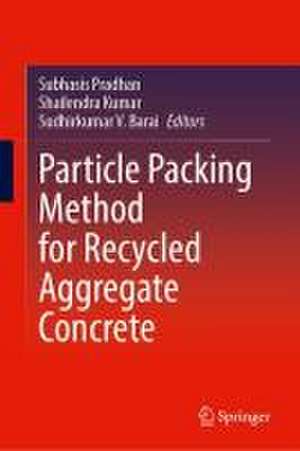Particle Packing Method for Recycled Aggregate Concrete
Autor Subhasis Pradhan, Shailendra Kumar, Sudhirkumar V. Baraien Limba Engleză Hardback – 28 feb 2024
Preț: 898.43 lei
Preț vechi: 1095.65 lei
-18% Nou
Puncte Express: 1348
Preț estimativ în valută:
171.91€ • 179.97$ • 142.25£
171.91€ • 179.97$ • 142.25£
Carte disponibilă
Livrare economică 15-29 martie
Preluare comenzi: 021 569.72.76
Specificații
ISBN-13: 9789819975150
ISBN-10: 9819975158
Pagini: 275
Ilustrații: XXXIII, 275 p. 127 illus., 81 illus. in color.
Dimensiuni: 155 x 235 mm
Greutate: 0.66 kg
Ediția:2024
Editura: Springer Nature Singapore
Colecția Springer
Locul publicării:Singapore, Singapore
ISBN-10: 9819975158
Pagini: 275
Ilustrații: XXXIII, 275 p. 127 illus., 81 illus. in color.
Dimensiuni: 155 x 235 mm
Greutate: 0.66 kg
Ediția:2024
Editura: Springer Nature Singapore
Colecția Springer
Locul publicării:Singapore, Singapore
Cuprins
Background on Techniques for Sustainable Use of Recycled Aggregate and
Application of Particle Packing Method.- Production and Processing of Aggregates .- Characterization of Materials.- Particle Packing Method of Mix Proportioning and Modified Mixing Approach.- Macro Level Performance Assessment of Concrete: Conventional Approach.- Macro Level Performance Assessment of Concrete: Experimental Fracture
Analysis.- Performance Assessment of Concrete: Meso-, Micro-, Nano-level, and Physio-
chemical Analysis.- Life Cycle Assessment and Cost Analysis.- Structural Applications: Beam.- Structural Applications: Column.- Structural Applications: Slab
Notă biografică
Dr. Subhasis Pradhan is presently working as an Assistant Professor in the Department of Civil Engineering at Birla Institute of Technology & Science, Pilani, India. He graduated from Veer Surendra Sai University of Technology, India in 2011. He completed his M.Tech. in Structural Engineering from Indian Institute of Technology (IIT) Guwahati in 2014 and subsequently joined IIT Kharagpur for his Ph.D. research. His research on “Performance of Recycled Aggregate Concrete and Structural Members: Particle Packing Method of Mix Design Approach” during Ph.D. earned the acknowledgement from the research community. In January 2020, he joined Nanyang Technological University (NTU) as a Postdoctoral Research Fellow. During Postdoc he worked on alternative binders, such as LC3 binder and one-part geopolymer while using marine clay, which is one of the major construction wastes in Singapore. His Ph.D. and postdoc research works are published in journals of international repute.Moreover, a Singapore patent is filed based on his research on LC3 binder using marine clay. His main research interests are in concrete technology, sustainable construction materials, alternative binders, geopolymer, CO2 sequestration in concrete, microstructural characterization, fracture behavior of concrete, Life Cycle Assessment and behavior of reinforced concrete members (beam, column and slab).
Dr. Shailendra Kumar is a Professor of Civil Engineering Department, School of Engineering & Technology, Guru Ghasidas Vishwavidyalaya, India. Before this, he was a faculty member at National Institute of Technology (NIT) Jamshedpur. He pursued his undergraduate degree from NIT Jamshedpur, post graduate degree from NIT Rourkela and Ph.D. from Indian Institute of Technology (IIT) Kharagpur. His main research areas are concrete fracture mechanics, fibre-reinforced concrete, alternate construction materials, etc. He published more than 75 research papers in national/ international journals/conferences and authored 02 books on Concrete Fracture Models (published by Springer) and Applications and Simplified Testing Methods of Double-K Concrete Fracture Model. He has executed 02 sponsored research projects under MHRD/UGC and supervised many M.Tech. and Ph.D. thesis works. He has been one of the members of the Technical Committee of “RILEM TC265-TDK” who developed the theoretical and experimental standardization of Double-K Fracture Model of concrete which have been published through 04 research papers in Materials & Structures in 2021.
Dr. Sudhirkumar Barai is a Director and Senior Professor of Civil Engineering at Birla Institute of Technology & Science Pilani, India. He is also a Professor in the Department of Civil Engineering, Indian Institute of Technology (IIT) Kharagpur availing lien for the current position since January 2020. In 1995, he obtained Ph.D (Eng.) from Indian Institute of Science (IISc) Bangalore. He received the degrees of B.E. (Civil) and M.E. (Civil) with specialization in structural engineering in 1987 and 1989, respectively, from the Faculty of Engineering, MS University of Baroda, India. He was Erskine Visiting Fellow at University of Canterbury, Christchurch, New Zealand during May-June 2008. He was also visiting scientist at National University of Singapore during May-July 2003. He was recipient of BOYSCAST fellowship and visited Department of Civil and Environmental Engineering, Carnegie Mellon University, Pittsburgh, USA during May-November 2000. He was a post-doctoral fellow at Department of Solid Mechanics, Materials and Structures, Tel Aviv University, Israel during February 1997-July 1998. His areas of research are sustainable construction materials, structural health monitoring and computational intelligence in engineering. He has published more than 250+ papers in leading international journals and conferences in his research fields. He has co‐authored four books‐ (1) Concrete Fracture Models and Applications (2) Shear Strengthening of T‐beam with GFRP: A Systematic Approach and (3) Systematic Approach of Characterisation and Behaviour of Recycled Aggregate Concrete, (4) Stability and Failure of High Performance Composite Structures, which have been published by Springer.
Textul de pe ultima copertă
This book highlights the use of commercially available recycled aggregate concrete (RAC) extracted from multiple construction and demolition sites, considering it as a viable alternative to conventional aggregate. It further describes the advanced techniques, such as, scanning electron microscopy, nanoindentation, thermogravimetric analysis and X-ray microtomography shedding light on the deep-rooted causes of inferior macro-mechanical performance of RAC and the advantages of particle packing method design approach in this regard. It then describes the improved properties of RAC with the help of macro-mechanical performance studies, microstructural characterization and fracture analysis. The systematic and in-depth presentation of the use of recycled coarse aggregate as an alternative to conventional aggregate for the preparation of structural concrete will guide researchers on subsequent research in RAC and provide assistance to structural engineers and concrete manufacturers for the usage of RAC.
Caracteristici
Enriches understanding by including contributions from leading experts across the globe Detailed focus on Particle Packing Method (PPM) and its use in the mix design of Recycled Aggregate Concrete (RAC) Highlights microstructural analysis of RAC using advanced techniques
